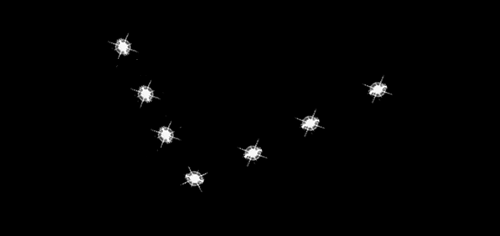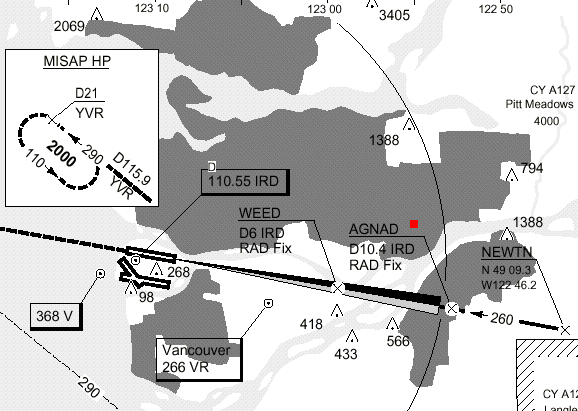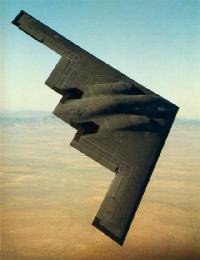The New Westminster "Boomerang"
Seven lights in "V" formation over the city of New Westminster, BC.
Observed 1997 December or 1998 January.
Reported 1998 September.
Final Report.
Investigated by Roger Smith.
Introduction
It was a dark, clear winter's evening, around 6 p.m.. A lady, alone in her car, was driving along Columbia Street (a main thoroughfare) towards and close to the Patullo Bridge that crosses the Fraser River in the city of New Westminster. Through her windshield, about 60-70° up and to her right, she noticed seven equally spaced lights in "V" formation; they were moving away from her in a direct line towards the west or south west. Each light was constant in intensity and white in colour.

Computer generated image submitted by the witness, a graphics artist.
"There were seven lights lined up like geese with an angle between the two rows of approximately 90 degrees".
The duration of the sighting was considered to be from a few seconds to one minute; the lady was concentrating on her driving at the time, reported the event some 9 months after experiencing it (when she discovered the UFO*BC web site), and she cannot be certain as to the duration and the date of the observation.
The lady was familiar with aircraft passing by - Vancouver International Airport is nearby - but this was different:
"I thought it was interesting but thought it was just some plane I'd never noticed before. When I got home my son who works for Air Canada and my husband who also works at the airport were in the kitchen and I asked them if they knew what kind of plane had those kind of lights and they both said at the same time, "None."".
I too know of no aircraft that displays this "V7" (my term) light arrangement and I have spent literally hundreds of hours observing and photographing aircraft. Naturally, when this incident came to my attention it aroused my curiosity and I investigated it further; in so doing I discovered other factors that add to the degree of strangeness of this event. The salient points are noted below:
Unknown light arrangement
The lady did not observe any structure, just the seven white lights in the pattern of a "V":
"The speed was similar to a landing plane approaching the airport
[Vancouver International, CYVR] although it was rather low but not so low that I felt it was strange. I saw nothing at all holding them [the lights] in place and they moved as though they were attached to a single vehicle".
"They [the lights] did not light up anything [on the ground] at all. They did not separate but remained at a constant distance apart from one another".
No known aircraft has this arrangement of lights.
The close and constant distance of the lights from each other would appear to eliminate formation flying by seven separate aircraft with spotlights (as too would the lack of navigation and anti-collision lights; see later notes).
Location of the lights
In normal operations, which are highly proceduralised, commercial aircraft do not fly their approaches into Vancouver International Airport over the city of New Westminster; rather, they fly south of it and above Annacis Island which is in the Fraser River.

An example of part of an Approach Plate used by
pilots when approaching to land on Runway 26R
at Vancouver International Airport. The red box depicts the approximate position of the V7 lights.
Vancouver International bound traffic would be expected in the New Westminster area only if they were making a west-bound landing on the north-most of Vancouver International's two parallel runways (Runway 26R; "runway two six right"); all other approaches would take the aircraft away from the city.
If, as the lady assumed, this was an aircraft landing at Vancouver International Airport then the low-level pass over the city was unusual; the observed position of the lights was some 6 km (4 miles) north of the final approach track on which a west-bound landing aircraft should have been positioned at that stage in it's approach. Air Traffic Control radar vectoring of pass-through (none landing) traffic may possibly result in such traffic passing over New Westminster, but usually it would not.
The regulatory airspace in which the Vancouver International bound traffic pass through in the New Westminster area has a minimum height above sea level of 2,500 feet; air traffic should not be lower than this.
Underside lighting
The white lighting was on the 'underside' of the structure if it is assumed that the "V7" lighting was part of one structure.
"The lights were in front of me and moving away from me. Now that you mention aircraft lights shining forward
[the landing lights] the lights had to have been beneath the craft, like [the] bottom side of a boomerang ...".
What use a conventional aircraft can make of seven bright lights pointing downwards remains open to question.
Lack of mandatory aircraft lighting
The lady has confirmed that there were no flashing white anti-collision lights nor fixed intensity red (port) and green (starboard) navigation lights. Such lighting would have been obvious if present and it is something that all aircraft must display; it is a mandatory requirement (exceptions apply for military aircraft but most certainly NOT when they are operating at low level in peacetime over major cities in civilian Air Traffic Control Zones with dense air traffic).
Relative size of the lights
The lady reported that:
"... EACH light was as big as a dime or almost as big held at arms length (I found a dime and tried it out
[this was during my investigation] ). It was quite close to the ground as it was landing (?) I think. Such as a large plane would look as you stand on No. 3 Road in Richmond near the airport. I only hope my memory is not making this larger than it really was".
As further guidance she also gave the analogy:
"See if this helps. The lights were the size of headlights on a car as you stand about 20 feet away from the car".
The size of a dime at the lady's arm length and a typical car headlight at 20 feet are actually very close to being the same relative size. The "No. 3 Road" analogy implies something smaller for the light diameter; however, given that any aircraft at No. 3 Road would be about 360 feet above the ground with just over 2 km to go until landing, clearly something was amiss if it had been over the city of New Westminster, some 18.5 km / 11.5 mile from the airport runway and above a hill with a high point of around 400 feet.
Whatever the lady's recollections of this event, her descriptions of what she saw imply something large indeed.
The lady further judged the distance between one light and the next to be 5 to 6 times the diameter of each light. This would prove useful in my calculation of the span distance of the lights (see later).
Relative size of the structure
 |
The lady reported that:
The Northrop B-2 "Spirit" stealth bomber has a wingspan of 52.5 metre or 172 feet (the size of a large commercial jet aircraft), so this gives a starting approximation as to the size of structure that was observed; we appear to be talking large commercial jet size. |
Determining the actual size of the lights and their span
What particularly interested me from this was devising a means to assess (estimating via calculation) as objectively as possible the minimum diameter that each light could have been and then, following from this, the minimum span of the lights (the distance between the outer parts of the two lights at the open end of the V) . I could then compare these results to known aircraft types.
Such calculations are relatively easy to do with a basic knowledge of trigonometry; indeed, it intrigued me somewhat to be calculating the height of a 'flying triangle' by using the mathematics of triangular geometry!. However, what makes the results of these calculations 'fuzzy' is the building in of error margins for the observations and the need to make some assumptions, particularly that of the height of the lights above the ground and a value to compensate for the real size of a light as opposed to it's 'glare size' (ie with a corona). A number of approaches can be taken to address these issues but the end result will always be subjective to a degree; I therefore prefer to look upon the calculated results as 'feel factors' and I present them only as examples in this context.
Judging the size of something is never an easy task when faced with the unfamiliar (and difficult enough even for the familiar; how many people can, for example, judge the height of an aircraft or a tree to within, say, 80-100% of it's true value?). I asked the witness to apply an error margin to her judgment: Given that she may have over-estimated the size, what would be the smallest size she would accept in her opinion?. The answer was 50% of the size of a dime at arm's length (90% of the size of a dime at arms length was considered to be the most likely size by the witness). I have therefore taken these range limits into consideration for my calculations, but I have also calculated the sizes on the basis that the real size of each light was 5x SMALLER than even the smallest the witness considered it could have been. Even when this very large margin for error is put into the calculations, the figures reveal some remarkable results (see following).
As for the height of the lights, the witnesses description suggests something on par with the height of the usual commercial air traffic than, say, a small aircraft flying very low. My approach, therefore, has been to assume that the lights were around the height of a commercial aircraft inbound to Vancouver International; by so doing it is then known that they would not have been below 2,500 feet above sea level (Air Traffic Control regulations) and more typically would have been around 3,000 feet if it was to intersect the "Glide Slope" radio beam that guides the aircraft down to the runway at Vancouver. As I am interested in calculating only the minimum possible sizes for comparison with known aircraft I can base my calculations on these lower heights; I have also included calculations for 1000 feet even though this would be irregulalrly low for a conventional aircraft. If the lights were lower than 1,000 feet then they will be smaller than the calculations suggest; however, they would need to be around 250 feet or lower (at an error margin of 1/9th the size the witness thought them to be) to be the size of a conventional light on an aircraft (that is dangerously low for any aircraft to be in this area; indeed it is practically impossible as the aircraft would be IN the hill).
Based upon the above factors the following results arise:
If the height of the lights was: |
If the
error margin for the |
The
diameter |
The span
across the |
|
|
|
|
1,000 ft |
Observer's maximum size. |
9 metre / 29 ft |
231 metre / 756 ft |
1,000 ft |
Observer's minimum size. |
5 metre / 16 ft |
128 metre / 420 ft |
1,000 ft |
Half observers minimum size. |
2.5 metre / 8 ft |
64 metre / 210 ft |
1,000 ft |
One fifth observers minimum size. |
1 metre / 3 ft |
26 metre / 84 ft |
2,500 ft |
Observer's maximum size. |
22 metre / 72 ft |
576 metre / 1890 ft |
2,500 ft |
Observer's minimum size. |
12 metre / 40 ft |
320 metre / 1050 ft |
2,500 ft |
Half observers minimum size. |
6 metre / 20 ft |
160 metre / 525 ft |
2,500 ft |
One fifth observers minimum size. |
2.5 metre / 8 ft |
64 metre / 210 ft |
|
|
|
|
3,000 ft |
Observer's maximum size. |
26 metre / 87 ft |
691 metre / 2269 ft |
3,000 ft |
Observer's minimum size. |
15 metre / 48 ft |
384 metre / 1260 ft |
3,000 ft |
Half observers minimum size. |
7 metre / 24 ft |
192 metre / 640 ft |
3,000 ft |
One fifth observers minimum size. |
3 metre / 10 ft |
77 metre / 252 ft |
Taking the scenario with the smallest result for the mimimum regulatory height of a commercial airliner inbound to Vancouver International, which assumes that the actual light size was just 1/5th (20%) of the MINIMUM size that the observer judged they could have been (and 1/9th the size of what the observer judged they were more likely to have been), the result is still a staggering 2.5 metre (8 feet) for the diameter of each light. This is far larger than any light on any known aircraft.
The resulting span between such lights becomes 64 metre (210 feet), assuming a distance between each light of 5 light diameters. This interestingly is the wingspan of a Boeing 747-400 (Jumbo Jet) passenger aircraft (64 metre / 211 feet).
If the error margin is reduced, but still assuming a light half the size of the smallest the observer thought it could be, the resulting span calculations far exceed that of any known flying aircraft by at least a factor of 2 at 2,500 feet. Examples:
Aircraft with the largest known wingspan: Antonov 124 transporter (Russia)
73.0 metre = 239.51 feet
Lockheed C-5A Galaxy military transporter (USA)
67.9 metre = 222.71 feet
Largest commercial passenger jet wingspan: Boeing 747-400
64.4 metre = 211.30 feet
Another large, locally common, commercial jet: Airbus A340-300
60.3 metre = 197.84 feet
Military 'bat wing': Northrop B-2 Spirit Stealth Bomber (USA)
52.4 metre = 172.00 feet
Other strange activity in this area
Two independent witnesses reported to UFO*BC a "V3" (my term) event that occurred around 10pm on the night of Wednesday 1998 March 18, this being 2-3 months after the event detailed in this report. This later event was reported from witnesses living near the Patullo Bridge which is just 2.5 km / 1.5 mile from where the "V7" light formation appears to have been.
Witness one reported:
"Earlier this evening I was visiting in the Patullo Bridge area of Surrey. My boyfriend and I were watching TV and were at a commercial break. He was half asleep and I was eagerly awaiting the beginning of Primetime. My eye caught a bright light out the window which faces the bridge looking towards the Coquitlam area. It was three round bright white lights in the shape of triangle with bluish rims around each. They were in a stealth bomber like shape where two of the lights are a little wider apart at the bottom. It was not directly above me but seemed to be tilted slightly so I could see the formation. It paused for only a second and then shot off to the west and down, leaving a stream of bright light. My first thought was a plane had crashed. I jumped up with a sick feeling in my stomach an got a little closer to the window waiting to see an explosion of light. However, nothing happened. The time was between 9:57 and 9:59pm."
When I asked if there had been any structure between the lights that the witness could determine, the witness reported that:
There was "Definitely substance. It really looked like a stealth bomber shaped aircraft with a sleek smooth look"
.
As for the lights, they were said to be:
"Just a little smaller than a dime at arms length and really bright".
A UFO*BC investigator who contacted the second witness described:
"I talked to the witness ... and he told me last night at 10:01 he was alerted to a bright white-blue light seen descending in the South-West sky. Although the object was first observed through his venetian blinds it was bright enough to bring him outside as he was certain he was seeing a plane crash. After being outside 5 minutes and content that he was going to see no more of the prior lightshow he was surprised to observe a orange fireball type light moving much slower than a comet once again heading South West. It then just "faded out" according to the witness".
These observations came just two days after a UFO*BC member had reported seeing a flying triangle over the city of Surrey, this to the south side of the Fraser River and not far from the area discussed in this report:
"... to-night about 11:15, I saw a triangular object moving at a really good clip in a s.e. direction. Didn't appear to be at a great altitude, not a sound heard. Definite triangle shape, with 3 (I think) very faint whitish coloured lights in a definite triangle shape. This would not have been noticed had I not been looking up at the precise moment it went by. Hard to imagine any one else seeing this unless they were looking at that part of the sky. I just popped out onto the back steps to look at the stars, and it went whizzing by. Fantastic! ... ".
Corroboration
The witness contacted UFO*BC on discovering it's web site, and did so in the hope that others had reported the event that she had experienced and which has been described in this report. They had not, and to this day this is the only eyewitness account that has been received about this event.
 RETURN TO 2000
INDEX
RETURN TO 2000
INDEX